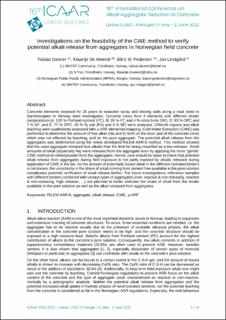| dc.description.abstract | Concrete elements exposed for 26 years to seawater spray and deicing salts along a road close to Sandnessjøen in Norway were investigated. Concrete cores from 4 elements with different binder compositions (A: 100 % Portland cement (PC), B: 96 % PC and 4 % silica fume (SF), D: 93 % OPC and 7 % SF, and E: 77 % OPC, 20 % fly ash (FA) and 3 % SF) were analysed. Chloride ingress and alkali leaching were qualitatively assessed with µ-XRF elemental mapping. Cold Water Extraction (CWE) was performed to determine the amount of free alkali (Na and K) both on the inner part of the concrete cores which was not affected by leaching, and on the pure aggregate. The potential alkali release from the aggregates was determined using the newly developed RILEM AAR-8 method. This method showed that the used aggregate released less alkalis than the limit for being classified as a low-releaser. Small amounts of alkali (especially Na) were released from the aggregate even by applying the more "gentle" CWE method on milled powder from the aggregates. Hence, care should be taken to check that potential alkali release from aggregates during field exposure is not partly masked by alkalis released during application of CWE in the lab. As the amount of potentially bound alkali in the different hydrated binders is not known, the uncertainty in the share of alkali coming from cement free available in the pore solution complicates potential verification of alkali release further. For future investigations, reference samples with different binders combined with various types of aggregates (non- reactive & non releasing, reactive & non-releasing, high releaser, ...) are planned to better estimate the share of alkali from the binder available in the pore solution as well as the alkali released from aggregates. | en_US |
